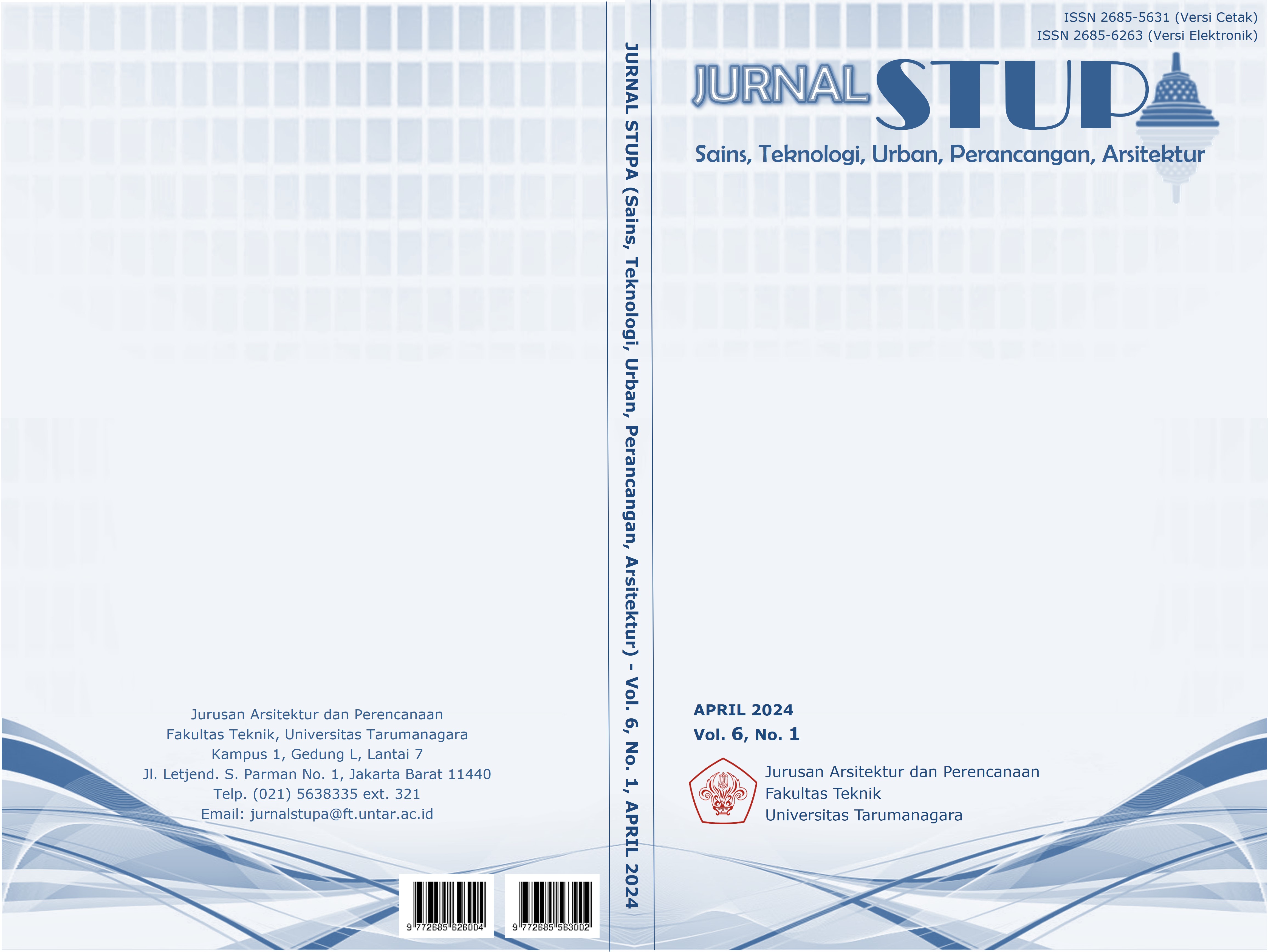PENERAPAN PENDEKATAN EKSPERIMENTAL RASIONALISME YANG EMPATIK DALAM DESAIN FASILITAS PENGOLAHAN UDARA BERSIH DI JAKARTA
Main Article Content
Abstract
Jakarta ranks among the top 10 cities with the highest pollution levels globally. Architecture can play a role to help reduce air pollution by implementing air purification technology within buildings. This design method represents the application of experimental rationalism that has not been tried before. With experimental rationalism, the air filtration technology in the design becomes the basis for an empathetic program within the building. The primary purpose is to provide a healthy space for the general public, whose daily lives are threatened by health risks triggered by air pollution. The emerging program includes an air-based therapy space, a research and education center on air pollution and air filtration technology, and commercial areas to complement the building's facilities. The empathy emphasized is towards the people of Jakarta, particularly their health risks. The building is envisioned to be a facility for healthy air processing accessible to everyone, aiming to empathize with the community and its health conditions by implementing modern air filtration technology capable of filtering harmful pollutants in Jakarta's air.
Keywords: air filtration technology; air purification architecture; empathetic program; experimental rationalism
Abstrak
Jakarta menginjak peringkat 10 besar sebagai kota dengan polusi tertinggi di dunia. Disini arsitektur bisa berperan untuk membantu reduksi polusi udara, dengan cara mengimplementasikan teknologi penyaring udara dalam bangunan. Metode desain ini merupa penerapan eksperimental rasionalisme yang belum pernah dicoba sebelumnya. Menggunakan penerapan eksperimental rasionalisme, teknologi penyaring udara dalam desain dijadikan basis program empatik dalam bangunan, dimana pengolahan udara bersih yang diproduksi oleh bangunan tersebut dijadikan kegunaan utama bangunan, yang bertujuan untuk menyediakan fasilitas ruang sehat kepada masyarakat umum yang kesehariannya terancam oleh resiko kesehatan dipicu oleh polusi udara. Program yang dimunculkan adalah ruang terapi berbasis udara sehat, pusat riset dan edukasi polusi udara dan teknologi penyaring udara, serta area komersil untuk melengkapi fasilitas bangunan. Empati yang diambil merupakan empati terhadap masyarakat Jakarta. Empati terhadap kesehatan mereka yang di ancam oleh resiko kesehatan. Bangunan ini menjadi sebuah fasilitas pengolahan udara sehat yang dapat diakses oleh semua orang, dan bertujuan untuk berempati terhadap masyarakat dan kondisi kesehatannya dengan cara menerapkan teknologi modern penyaring udara yang dapat memfiltrasi polutan buruk di udara Jakarta.
Article Details

This work is licensed under a Creative Commons Attribution-NonCommercial-ShareAlike 4.0 International License.
This work is licensed under a Jurnal Sains, Teknologi, Urban, Perancangan, Arsitektur/ STUPA Creative Commons Attribution-NonCommercial-ShareAlike 4.0 International LicenseReferences
Ariel B. (2022, May 12). Types of Air Purifiers. Retrieved from AirOasis.com: https://www.airoasis.com/blogs/articles/air-purifier-types
Goleman, D. (1995). Emotional Intelligence. The 10h Anniversary Edition.
Goleman, D. (1996). Kecerdasan emosional. Jakarta: PT. Gramedia Pustaka Utama.
Hoffman, M. L. (1977). Personality and social development. Annual Review of Psychology, 28(1), 295–321.
Hoffman, M. L. (2000). Empathy and moral development: Implications of caring and justice. New York: Cambridge University Press.
Patrick Pinaria. (2023, 6 September). Polusi Udara Penyebab Kematian Tertinggi ke-5 di Indonesia. Retrieved from medcom.id/gaya: https://www.medcom.id/gaya/fitness-health/yKXEdB0N-polusi-udara-penyebab-kematian-tertinggi-ke-5-di-indonesia
Toi, M., & Batson, C. D. (1982). More evidence that empathy is a source of altruistic motivation. Journal of Personality and Social Psychology, 42, 281–292.
Walsh, R. (1997). Why We Wept for Little Nell: Character and Emotional Involvement. Narrative 5(3): 306 –21.
Wiseman, T. (1966). A Concept Analysis of Empathy. Journal of Advanced Nursing 23,1162-1167.



